Blog Archives
Garden Recipe Roundup
When we have some less common veggies in the garden, I always try to cook something with a few of them to show how they might be used and to give them a fair taste test. Many of you know that I’m not a huge fan of eggplant, but I decided that I should give an eggplant dish a try anyway. I also made stewed okra and tomatoes, because I’ve never really cooked with okra before and wanted to try it in a form other than breaded and fried.
First up: Thai Fried Eggplant with Basil
I like Thai food, and we had all the recipe and sauce ingredients on hand, so it worked out well. I used the green Oriental eggplant, the yellow ‘Escamillo’ sweet peppers and one of the purple sweet peppers, one of the Round Purple Asian eggplants, a red onion from my home garden, and a couple ‘Gong Bao’ peppers from my home garden in place of the serranos. I also used Thai basil rather than regular sweet basil.
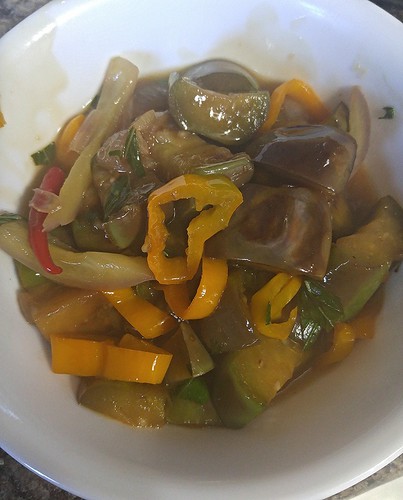 I found the sauce to be a little heavy, flavor-wise. It probably needed a bit more acid, maybe some lime juice. Overall, it wasn’t bad (for eggplant). The texture still isn’t my favorite, but it wasn’t completely distasteful.
I found the sauce to be a little heavy, flavor-wise. It probably needed a bit more acid, maybe some lime juice. Overall, it wasn’t bad (for eggplant). The texture still isn’t my favorite, but it wasn’t completely distasteful.
Next up: Stewed Okra and Tomatoes
 I used the okra and tomatoes from the garden, including some of the big okra that is larger than would typically be ideal. The ‘Ladyfinger’ okra that we are growing is supposed to be tender and usable even at larger sizes, so I wanted to test that out. I would say that it was nice and tender after the stewing, up to about 10″ long. After that, the pieces were still a bit fibrous and woody. I doubt a longer cook time would have solved the problem.
I used the okra and tomatoes from the garden, including some of the big okra that is larger than would typically be ideal. The ‘Ladyfinger’ okra that we are growing is supposed to be tender and usable even at larger sizes, so I wanted to test that out. I would say that it was nice and tender after the stewing, up to about 10″ long. After that, the pieces were still a bit fibrous and woody. I doubt a longer cook time would have solved the problem.
Both recipes were fairly easy, did a nice job featuring the vegetables, and were tasty. If you are looking for a recipe to use for eggplant or okra, give these a try!
Friday PhotoEssay – July 15, 2016
With another week of sun, rain, and heat, the garden continues to grow quickly. Many of our vines and other warm season vegetables are finally putting on some good growth. Surprisingly, the tomatoes are still looking really good with minimal signs of disease or other problems.
 Many of the plants have reached full-size, although the vining crops have yet to fill the trellises.
Many of the plants have reached full-size, although the vining crops have yet to fill the trellises.
 The Oriental Garden is really starting to look good. This ‘Ladyfinger’ okra didn’t germinate very well, but looking at the plants now, I’m glad that we only have 4 or 5 plants. They are starting to take over the surrounding area already! There are just a few buds starting to develop. Maybe by next week there will be some okra to show.
The Oriental Garden is really starting to look good. This ‘Ladyfinger’ okra didn’t germinate very well, but looking at the plants now, I’m glad that we only have 4 or 5 plants. They are starting to take over the surrounding area already! There are just a few buds starting to develop. Maybe by next week there will be some okra to show.

The ‘Goddess’ banana peppers are showing off this summer. We’ve grown banana peppers many times, but this variety is by far the most productive of the ones we’ve grown recently. The three plants have been loaded with peppers.
 The Pollinator garden is looking great with bright colors of the milkweeds, zinnias, and sages. This garden will just continue to grow, change, and get more beautiful as the summer progresses.
The Pollinator garden is looking great with bright colors of the milkweeds, zinnias, and sages. This garden will just continue to grow, change, and get more beautiful as the summer progresses.
 As I said earlier, the vines are just starting to take off. This is the Oriental garden. The left side of the trellises has beans and the luffa gourd. The right side of the trellises has cucmbers and melons. They are just starting to set fruit.
As I said earlier, the vines are just starting to take off. This is the Oriental garden. The left side of the trellises has beans and the luffa gourd. The right side of the trellises has cucmbers and melons. They are just starting to set fruit.
 Do you know what this is? It is the flower of a passionflower/passionfruit vine. I don’t know if it will actually produce fruit, but we are watching it grow and bloom in our Pollinator Garden. It is just starting to climb up the trellis.
Do you know what this is? It is the flower of a passionflower/passionfruit vine. I don’t know if it will actually produce fruit, but we are watching it grow and bloom in our Pollinator Garden. It is just starting to climb up the trellis.
Have a great weekend!
Friday PhotoEssay – August 22nd
Whew! It’s hot and steamy out there! I’m regretting not going out to take pictures first thing this morning.
 As a result, you get the shadowy version of the whole garden today. Shadowy and slightly wilty, especially if you are talking about the pumpkins. It’s a good thing they’re almost ripe, because the plants are almost done for.
As a result, you get the shadowy version of the whole garden today. Shadowy and slightly wilty, especially if you are talking about the pumpkins. It’s a good thing they’re almost ripe, because the plants are almost done for.
 Also in the not so spectacular category are the zinnias. They usually look great, until all of a sudden they have powdery mildew. Then they look awful until we decide to take them out. And that is really the best option. I think we’re getting near that point here.
Also in the not so spectacular category are the zinnias. They usually look great, until all of a sudden they have powdery mildew. Then they look awful until we decide to take them out. And that is really the best option. I think we’re getting near that point here.
 Apparently the peanuts are thoroughly enjoying the weather, because they are growing like crazy. I know they don’t look like much from the top, but I’m hopeful that they will be pretty spectacular when we harvest later this fall!
Apparently the peanuts are thoroughly enjoying the weather, because they are growing like crazy. I know they don’t look like much from the top, but I’m hopeful that they will be pretty spectacular when we harvest later this fall!
 Have I give you the spiel on how peanuts grow already? I can’t remember. Anyway, what you are looking at in the very center of the picture are the ovary tubes growing down into the soil that will grow the peanuts. Those reddish-brown sticks coming off the stem are what I’m talking about. The plants are still blooming too, which means even more peanuts!
Have I give you the spiel on how peanuts grow already? I can’t remember. Anyway, what you are looking at in the very center of the picture are the ovary tubes growing down into the soil that will grow the peanuts. Those reddish-brown sticks coming off the stem are what I’m talking about. The plants are still blooming too, which means even more peanuts!
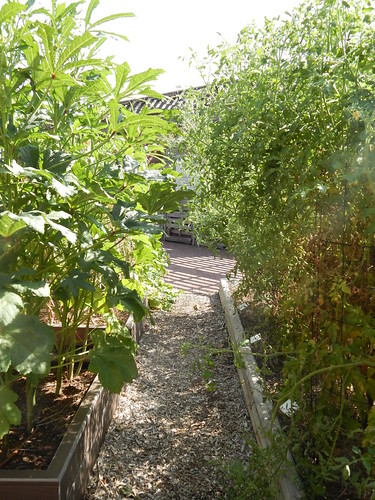 Ironically, the trellis over the walkway has been rather pathetic this year, with both varieties not doing a lot of climbing. But who needs a trellis arch when the okra and the tomatoes can grow together over the path all by themselves? It’s starting to feel a bit like a jungle out here.
Ironically, the trellis over the walkway has been rather pathetic this year, with both varieties not doing a lot of climbing. But who needs a trellis arch when the okra and the tomatoes can grow together over the path all by themselves? It’s starting to feel a bit like a jungle out here.
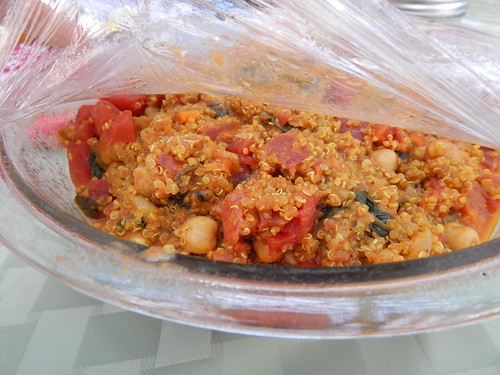 Denise made some yummy Indian dishes for our Saturday Sampler last Saturday. This is the Quinoa Chickpea Curry. The recipes should be up on the website soon, but in the meantime you can revisit other recipes here: Saturday Sampler Recipes.
Denise made some yummy Indian dishes for our Saturday Sampler last Saturday. This is the Quinoa Chickpea Curry. The recipes should be up on the website soon, but in the meantime you can revisit other recipes here: Saturday Sampler Recipes.
Have a great weekend!
Friday PhotoEssay – August 15th
It’s Friday! And you can tell that the garden is continuing to wind down into fall. I will have to look back and see at what point the garden stops getting greener and starts getting browner. We are definitely into the “browner” stage right now.
 I guess it’s still pretty green though, at least from a distance. It helps that you can’t really see the quinoa from this angle.
I guess it’s still pretty green though, at least from a distance. It helps that you can’t really see the quinoa from this angle.
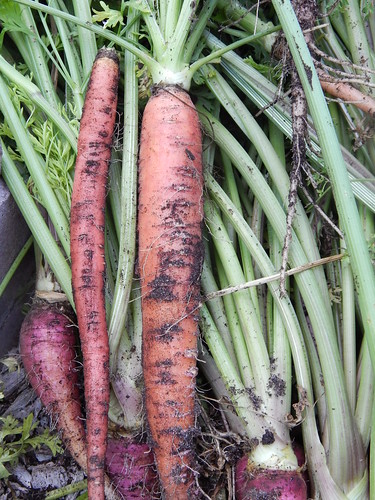 We did harvest the ‘Kesar’ and ‘Red Samurai’ carrots from the India Garden this week. They were pretty good sized! Unfortunately, they had just enough exposure to heat this summer to make them pretty bitter. Ideally we would have harvested them earlier, but since they got started late, they really weren’t ready. Honestly, they were pretty yucky.
We did harvest the ‘Kesar’ and ‘Red Samurai’ carrots from the India Garden this week. They were pretty good sized! Unfortunately, they had just enough exposure to heat this summer to make them pretty bitter. Ideally we would have harvested them earlier, but since they got started late, they really weren’t ready. Honestly, they were pretty yucky.
 So the ‘Kesar’ carrots, which were billed as “red” were actually purple skins with yellow interiors. I guess that is yet another lesson to take catalogue descriptions with a grain of salt.
So the ‘Kesar’ carrots, which were billed as “red” were actually purple skins with yellow interiors. I guess that is yet another lesson to take catalogue descriptions with a grain of salt.
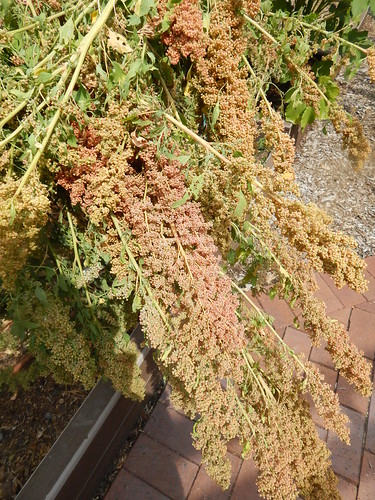 The quinoa is still flopped over from the wind and storms last week, and it continues to develop some more color! I hope the color keeps getting brighter, otherwise I’m going to be sad.
The quinoa is still flopped over from the wind and storms last week, and it continues to develop some more color! I hope the color keeps getting brighter, otherwise I’m going to be sad.
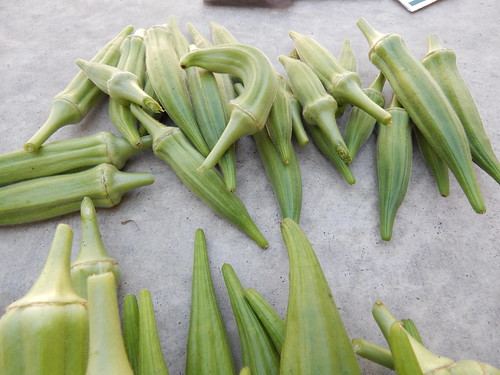 We also went through and harvested all the okra that was ready (and past ready). Most okra starts to get tough and stringy once it is more than 3-4″ long, so it is important to pick it as it reaches the right size. I read a blog post this week called “A Reason to Love Okra” which talks about how okra is cooked in India. I thought it was a really interesting insight into the different preparations of okra that we use.
We also went through and harvested all the okra that was ready (and past ready). Most okra starts to get tough and stringy once it is more than 3-4″ long, so it is important to pick it as it reaches the right size. I read a blog post this week called “A Reason to Love Okra” which talks about how okra is cooked in India. I thought it was a really interesting insight into the different preparations of okra that we use.
Speaking of which…tomorrow at 9 a.m. in the Demo Garden is our August Saturday Sampler program, and we are featuring Indian recipes and recipes with flavors of India. I know one of the recipes in the booklet is a Crispy Okra Raita, but I don’t know if that one will be up for sampling or not. Either way, you should come check it out!
Have a great weekend!
Harvesting Okra
Okra is one of those vegetables that I’m much less familiar with, and it also fits my category of “if you have to bread it and fry it to make it edible, it either isn’t edible or isn’t a vegetable.” That said, one of the biggest mistakes that people make with okra is harvesting it. I don’t know how many times I’ve seen grossly over-sized okra entered in a county fair.
 Okra goes from budded to over-mature in seemingly the blink of an eye. Here you can see the cluster of buds at the top and a couple flowers that are opening.
Okra goes from budded to over-mature in seemingly the blink of an eye. Here you can see the cluster of buds at the top and a couple flowers that are opening.
 Here’s the okra a couple days after flowering. Actually, I would consider the okra on the right to be just about the right size. If you gently squeeze it, it is still tender and not too woody. Woody okra – yuck!
Here’s the okra a couple days after flowering. Actually, I would consider the okra on the right to be just about the right size. If you gently squeeze it, it is still tender and not too woody. Woody okra – yuck!
 If you don’t harvest your okra regularly (every day or every other day), this is what you are going to end up with – huge okra that is extremely woody and not very tasty. The more medium sized pods on the left are probably still good for things like gumbo, although they are best slightly smaller.
If you don’t harvest your okra regularly (every day or every other day), this is what you are going to end up with – huge okra that is extremely woody and not very tasty. The more medium sized pods on the left are probably still good for things like gumbo, although they are best slightly smaller.
Another thing to be wary of when harvesting okra is that a lot of people are very sensitive to the hairs on the leaves and stems of okra plants. If you don’t want to get VERY itchy when you harvest, you may want to wear some combination of long sleeves, gloves, and use a pair of pruners or scissors!
Does anyone have a good okra recipe they’d like to share? (Other than breading and frying.)




